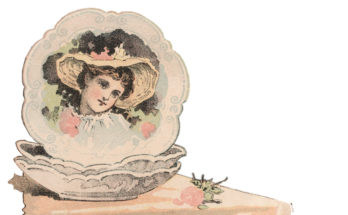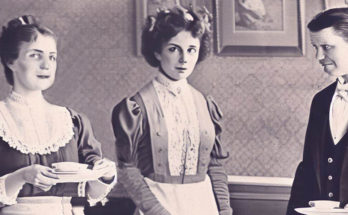1888: Hood’s Book of Home Made Candies, C. I. Hood Co., Proprietors of Hood’s Sarsaparilla, Lowell, Mass.
The whole difficulty of candy making is in understanding the boiling of sugar, and the effects of certain things on the boiled sugar…. Sugar, when boiled to what is known as the “snap” or the “crack,” will remain clear if not stirred. If, however, it is disturbed, either by the dipping of nuts into it or by stirring, it will become cloudy, and perhaps go back to sugar. For this reason vinegar or other acid is added to the syrup, which to a large extent prevents the clouding, and enables it to be handled for different purposes without spoiling the appearance. Here are three rules to remember:
- Avoid stirring or disturbing candy that is meant to be clear, more than can be helped.
- Never, when pouring out boiled candy, scrape the saucepan over it, not allow any of the scrapings of the saucepan to fall into it.
- Always use a thick saucepan, iron or enameled, to boil sugar.
To Boil Sugar for Clear Candy
Put one pound fo the best quality granulated sugar in a saucepan with half a pint of water; stir well before they boil, so that the sugar may not sink and burn; when dissolve, stir no more; when the sugar boils and fine bubbles appear, begin to try it in cold water; drop a little from the end of a fork into the water. If it snaps like glass between the teeth it has reached what is commonly called the “crack,” and is ready to make many kinds of candy. If the boiling is continued longer it will reach the point called caramel, when it takes a yellow color, and must be at once drawn from the fire. Caramel is a useful degree; the next one, however, means burning, and very few seconds are enough to do it.
Fruit Candies
These are far better when made of pure fruit juice than when only flavored with extracts. Boil a pound of sugar to the crack, add two teaspoonfuls of fruit juice, such as cherry, raspberry or currant, then boil till a bead dropped on a greased tin hardens. Drop the hot candy in buttons on the tins, and when cold put in air-tight boxes.
Lozenges.
These candies when god are never very cheap, and as for this reason they are frequently adulterated, it is worth while to learn how to make them.
Lemon Lozenges.
Soak one ounce of picked gum tragacanth for several hours in two ounces of tepid water, then when it is all quite tender wring it in a cloth; work this gum with the palm of the hand on a marble table or slab till it is very white and elastic; then gradually work in a pound and a half of confectioners’ sugar, and when the paste is firm and compact, add a teaspoon of oil of lemon and a few drops of acetic acid. Use this paste as you would dough, rolling it out with sugar in place of flour. When you have rolled it to the thickness of a nickel (or thicker if you wish), use a tin tube or cutter the size of a quarter, and stamp out the lozenges. As you do them, place them in rows on sugared baking sheets to dry in a warm place. When the first lot are stamped out, work up the trimmings, roll them out and use them up to the last bit.
Marshmallows Paste.
Soak half a pound of gum arabic in a pint of water, until soft. Add to it a pound of powdered sugar, stir all together in a double boiler, or in a saucepan set in another, until it is thick and white. Try it in water as soon as it thickens. If it forms a firm but not hard ball, it is done. Remove from the fire. If you want what is called “inflated” marshmallow, that is to say rather spongy, beat the whites of two eggs and add them gradually to the paste, then flavor with orange flower or rose; the former is generally used. The paste may be poured out on a pan or dish covered with corn-starch, and when cool it can be cut into squares and packed away in confectioners’ sugar till wanted. It will grow hard and dry in a few days.
Cocoanut Cream Bonbons
Grate some cocoanut fine. Mix it with as much of the boiled cream as will bind it into a paste, flavor with lemon or vanilla, make into small balls, part of which drop into white cream. The other part may bedipped into cream mixed with chocolate. To do this melt a piece of unsweetened chocolate in a cup with a teaspoonful of water. Mix this with enough cream to sweeten it, and use it for coating the rest of the cocoanut balls.
Testimonials for C. I. Hood Co. Tonics
Pictures shown in booklet (can be viewed on Reddit Cooking Booklets site)
1909: Mrs. Beardsley’s Daughter, Elmira Heights, NY
1911: Mr. C. C. Bailey, 64 1st South St., Champaign, Illinois
1908: Mrs. Emma Franklin, [32 Beeman St] Canandaigua, NY – I found her genealogy and sent a note for relatives that her portrait is here! She looks younger in the black and white picture.
1911: Mr. George M. Milligan, 181 Winthrop St., Roxbury, Mass.
Did they know that their testimonials would go down in history? I may have found somebody’s great-grandma!
32-page booklet. Publisher: C. I. Hood Co.



